Complete Solutions to CONCEPTIVE WORKSHEET of chapter OUR ENVIRONMENT of Class 6 book with complete answers and questions
| Class 6 | BIOLOGY |
| Chapter | OUR ENVIRONMENT |
| BETOPPERS | CONCEPTIVE WORKSHEET |
| Number Of Questions | 70 |
| Academic Year | 2023-24 |
The Earth revolves around the Sun in a nearly circular path, which is commonly called
View SolutionEarth completes one revolution around the Sun in
View SolutionOur solar system has __________ planets.
View SolutionEarth is __ planet from the sun
View SolutionThe farthest planet from tbe sun in the solar system is
View SolutionWhich is the following is the reason for the existence of life on the Earth?
View SolutionWhich of the following keeps the things on the surface of the Earth in place, but also holds the atmosphere and the oceans in place
View SolutionThe outer, rocky part around the Earth is called the
View SolutionThe lowest layer of atmosphere is
View SolutionMantle is made up of molten light materials, commonly called
View SolutionWhich of the following is the least abundant in earth's atmosphere?
View SolutionOxygen is the __________ abundant element in earth's atmosphere
View SolutionBiotic and abiotic components interact with each other in an ecosystem. Which of the following components of a grassland ecosystem is abiotic in nature?
View SolutionAmong soil, water, plants, rocks, and insects, the biotic components of the ecosystem are
View SolutionProducers are organisms that produce organic material from inorganic material and provide energy to animals directly or indirectly. Which of the following organisms is not a producer?
View SolutionProducers occupy which trophic level?
View SolutionProducers are organisms that manufacture their own food. Which of the following organisms is not a producer?
View SolutionThe population of which of the following animals would decrease with an increase in the tiger population of a forest ecosystem?
View SolutionTake the given food chain into account

Which of the following processes is depicted by the given arrow diagram?
View SolutionThe given figure shows a·food chain operating in a terrestrial habitat.

Which organism is the primary consumer in the given food chain?
View Solution
In the given food chain, the producer is
View SolutionThe illustration represents a forest food chain.

If the population of squirrel increases, then which of the following observations will be most probably true?
View Solution__________ and __________ are the consumers in the given food chain.

The information in which row completes the given statement?
View SolutionThe illustration shows a food web operating in a pond.
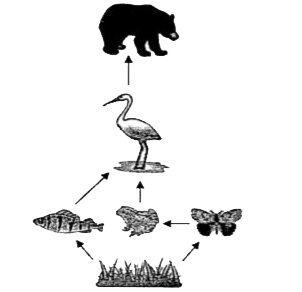
If the crane population decreases because of excessive hunting by humans, then which of the following observations will be most probably true?
View SolutionThe illustration represents a marine food chain.

If the killer whale population increases, then which of the following observations will be most probably true?
View SolutionDecomposers are organisms that decompose the remains of dead plants and animals to aid the recycling of matter.

Which organism is the decomposer in the given food chain?
View SolutionThe illustration represents a food web.
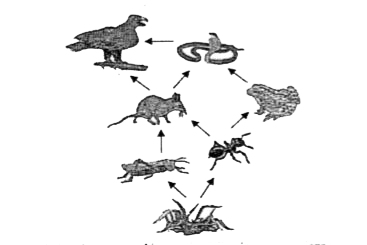
If the snake population decreases, which of the following observations will be most probably true?
View SolutionConsumers are the organisms that cannot manufacture their own food and are dependent on other organisms for food. The illustration represents a food chain

Which of the following pairs of organisms represents the consumers in the given food chain?
View SolutionThe illustration represents a food web operating in an ocean.
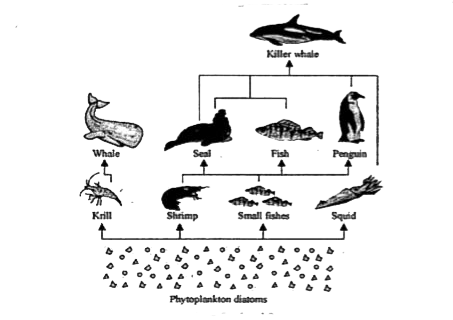
Which organism is a producer in the given food web?
View SolutionThe illustration represents a food chain.

Which organisms are consumers in the given food chain?
View SolutionThe illustration represents a food web.
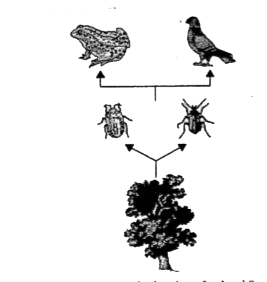
Which organism is the primary consumer in the given food web?
View SolutionThe illustration represents a marine food chain.

Which organism is the producer in the given food chain?
View SolutionThe highlighted portion of the given food web represents one of the food chains operating in the food web.
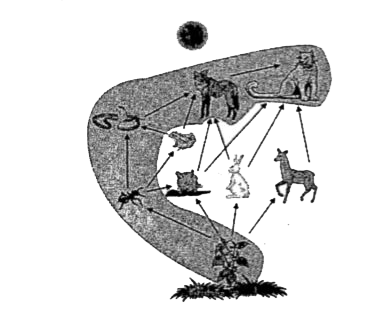
Which organism is the tertiary consumer in the given food chain?
View SolutionThe illustration represents a food chain.

Which organism is the decomposer in the given food chain?
View SolutionThe illustration represents a food chain operating in an ocean.

Which organism is the decomposer in the given food chain?
View SolutionThe illustration shows an ocean food web.
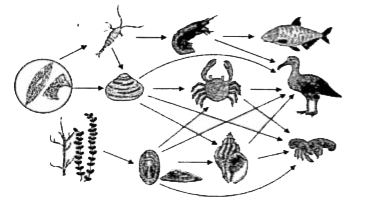
If the population of shrimp decreases, then which of the following populations would decrease?
View SolutionThe given figure represents a food web in a forest .
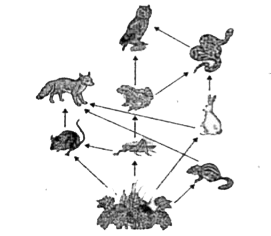
In the given food web, snakes obtain energy from
View SolutionWho are the producers in the given food chain?
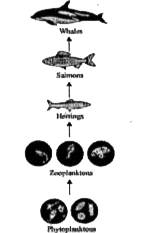
View SolutionThe given figure represents a food web.

Who is the producer in the given food web?
View SolutionThe given figure represents the food web of a river.

A decrease in trout population will lead to
View SolutionWhich organism will be the most affected if the mouse is removed from the given food web?
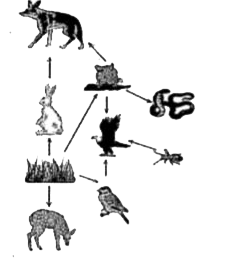
View SolutionWhich of the following organisms in the illustrated food web receives the least amount of energy?
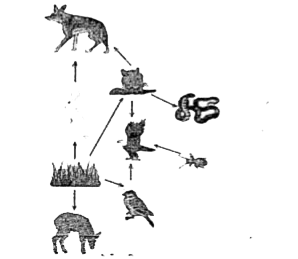
View SolutionThe given figure shows the aquatic food web of a particular region. Humans begin consmning more snails in the said region.
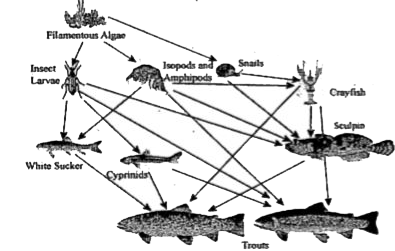
The over fishing of snails by humans will greatly affect the
View SolutionPhytoplanktons are an important part of ocean food chains. They are found in high productivity zones of an ocean. An increase in ocean temperature during specific times causes the death of phytoplanktons.
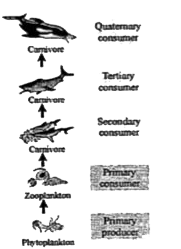
If all phytoplanktons die in the given food chain, then
View SolutionIn the illustarted food web, direct transfer of energy occurs from the
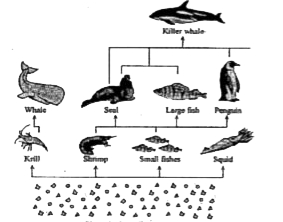
View SolutionA food chain depicts the flow of energy from one trophic level to another. Which of the following represents the percentage of energy transfer from one trophic level to the next?
View SolutionThe given pyramid shows a terrestrial food chain wherein 10,000 J of energy is present at the level of primary producers.
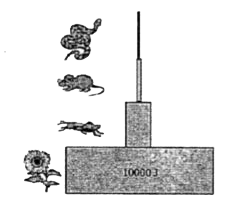
The amount of energy present at the level of mice is
View SolutionStatement - I: The temperature is measured by a device called manometer.
Statement - II: The degree of hotness or coldness of a body is called temperature.
View SolutionTigers and elephants are found in
View SolutionWhich of the following in popularly called ship of the desert
View SolutionCamel can live without food or water at a stretch for as many as
View SolutionAssertion (A): Leaves of desert plants have been reduced to spines
Reason (R): This is to reduce loss of water from the plant's surface
View SolutionWhich of the plant's Flowers bloom after sunrise and close down after sunset?
View SolutionWhich of the following plant has floating leaves?
View SolutionWhich of the following fruit has hairs?
View SolutionThe increase in carbon dioxide level in atmosphere leads to
View SolutionSmog is a mixture of fog and
View SolutionPlants depend on animals for
View SolutionMatch the following

View SolutionWhich of the following are bio-degradable pollutants?
View SolutionLead is a __________ pollutant.
View SolutionExcessive burning of fossil fuels like coal, kerosene, petrol and diesel leads to
View SolutionBronchitis and asthma are caused due to
View SolutionWhich of the following are water pollutants?
View SolutionWhich of the following causes water pollution?
View SolutionWhich of the following is caused due to water pollution
View SolutionWhich of the following are land pollutants?
View SolutionWhich of the following leads to land pollution?
View SolutionWhich of the following controls land pollution?
View SolutionWhich of the following controls noise pollution?
View Solution
CONCEPTIVE WORKSHEET questions and complete solutions for chapter OUR ENVIRONMENT of BETOPPERS of Class 6
All Exercises from BETOPPERS Class 6 BIOLOGY OUR ENVIRONMENT
- CONCEPTIVE WORKSHEET
- FORMATIVE WORKSHEET
- SUMMATIVE WORKSHEET (FILL IN THE BLANKS)
- SUMMATIVE WORKSHEET ( WHICH OF THE FOLLOWING STATEMENTS ARE TRUE (T) AND WHICH ONE ARE FALSE (F)? MARK T OR F)
- SUMMATIVE WORKSHEET (ANSWER THE FOLLOWING QUESTIONS:)
- SUMMATIVE WORKSHEET (DEFINE THE FOLLOWING TERMS:)
- SUMMATIVE WORKSHEET (GIVE THE DIFFRENCES BETWEEN THE FOLLOWING:)
- SUMMATIVE WORKSHEET (MULTIPLE TYPE QUESTIONS)